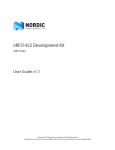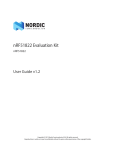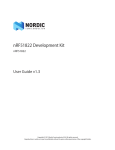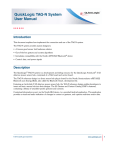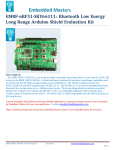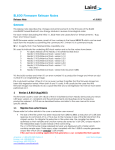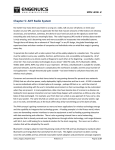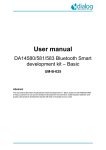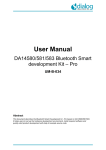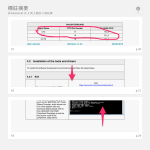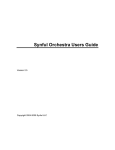Download nRF51822_422_Eval_Kit User Guide.fm
Transcript
nRF51422 Evaluation Kit nRF51422 User Guide v1.1 Copyright © 2013 Nordic Semiconductor ASA. All rights reserved. Reproduction in whole or in part is prohibited without the prior written permission of the copyright holder. nRF51422 Evaluation Kit User Guide v1.1 Contents 1 1.1 1.2 1.3 1.4 Introduction............................................................................................................................................... 3 Minimum requirements ................................................................................................................................. 3 External resources ............................................................................................................................................ 3 Writing conventions........................................................................................................................................ 3 Evaluation kit release notes .......................................................................................................................... 3 2 2.1 2.2 Kit content.................................................................................................................................................. 4 nRF51422 Evaluation Kit hardware content ........................................................................................... 4 Downloadable content .................................................................................................................................. 5 3 3.1 3.2 Quick start .................................................................................................................................................. 6 Install the nRF51422 Evaluation board (PCA10003) ............................................................................ 7 ANT Link demo .................................................................................................................................................. 8 4 4.1 Evaluation kit configuration................................................................................................................. 10 Development environment........................................................................................................................10 5 5.1 5.2 Hardware description ............................................................................................................................ 12 nRF51422 Evaluation Kit board (PCA10003).........................................................................................12 nRFready ANT USB dongle (nRF2779) ....................................................................................................20 6 6.1 6.2 Flash programming and application development......................................................................... 22 Programming and erasing flash using nRFgo Studio .......................................................................22 Application development ...........................................................................................................................25 7 7.1 Debugging the nRF51422 chip ............................................................................................................ 33 nRF51422 debug features and precautions .........................................................................................34 8 8.1 Software Development Kit ................................................................................................................... 38 Installing the nRF51 SDK..............................................................................................................................38 9 Troubleshooting ..................................................................................................................................... 39 Appendix A: Installing drivers and configuring KEIL projects for the SEGGER debugger .................................................................................................................................. 40 Page 2 of 47 nRF51422 Evaluation Kit User Guide v1.1 1 Introduction The nRF51422 ANTTM Evaluation Kit (EK) provides a complete solution for testing and evaluating the nRF51422 device. The nRF51422 is part of the nRF51 series which offers a range of ultra-low power, System on Chip (SoC) solutions for your 2.4 GHz wireless products. 1.1 Minimum requirements • nRFgo Studio v1.14 or later • Computer with a minimum of 2 USB ports • Windows XP or Windows 7 1.2 External resources • Keil MDK-ARM Lite v4.54 or later https://www.keil.com/demo/eval/arm.htm • J-Link Software v4.52b or later http://www.segger.com/jlink-software.html 1.3 Writing conventions This User Guide follows a set of typographic rules that makes the document consistent and easy to read. The following writing conventions are used: • • • • 1.4 Commands are written in Lucida Console. Pin names are written in Consolas. File names and user interface components are written in bold. Internal cross references are italicized and written in semi-bold. Evaluation kit release notes Date Kit version Description January 2013 2.0 Fixed known issue in kit v1.0. November 2012 1.0 Known issues PCA10003 v1.0: • The antenna matching network and layout on these boards is suitable for applications using TX output power 0 dBm or less. These boards are not suitable for applications using +4 dBm TX output power. Page 3 of 47 nRF51422 Evaluation Kit User Guide v1.1 2 Kit content The nRF51422 Evaluation Kit consists of hardware and access to software components, documentation, and design files from www.nordicsemi.com. The S210 nRF51422 SoftDevice is pre-programmed on the chip and cannot be deleted or modified. 2.1 nRF51422 Evaluation Kit hardware content 1 x Litium 3 V battery 1 x nRF51422 EK board (PCA10003) 1 x ANT USB dongle (nRF2779) Figure 1 nRF51422 Evaluation Kit hardware content Page 4 of 47 nRF51422 Evaluation Kit User Guide v1.1 2.2 Downloadable content The nRF51422 Evaluation Kit includes firmware source code, documentation, hardware schematics, and layout files. To access this information, log in to your My Page account, enter your product key, and download the files. Instructions can be found in chapter 3 on page 6. 2.2.1 nRF51422 software • nRFgo Studio • nRF51 Software Development Kit (SDK) • Precompiled HEX files • Source code • Keil ARM project files • ANTware II 2.2.2 nRF51422 documentation • • • • • • 2.2.3 nRF51422 Evaluation Kit User Guide nRF51 Series Reference Manual nRF51422 PS S210 nRF51422 SoftDevice Specification nRF51422 PAN ANT API documentation Schematics, Bill of Materials, PCB layout files, and production files The ZIP file and its subdirectories contain the hardware design files for the Evaluation Kit. • • • • Altium Designer files Schematics PCB layout files Production files • Assembly drawings • Drill files • Gerber files • Pick and Place files • Bill of Materials Page 5 of 47 nRF51422 Evaluation Kit User Guide v1.1 3 Quick start This section shows you how to set up the nRF51422 Evaluation Kit and provides example applications to help you start programming your device. Register, download, and install 1. If you have Keil MDK-ARM Lite already installed, go to step 2. Otherwise, download and install Keil MDK-ARM Lite from https://www.keil.com/demo/eval/arm.htm to your hard drive. Keil downloads to c:\Keil\ unless you change the location when installing. 2. Download and run the J-Link Software and documentation pack for Windows from http://www.segger.com/jlink-software.html. The serial number from your SEGGER J-Link hardware is needed to identify your device. 3. During installation you will be prompted to select the IDE that should be updated with the latest SEGGER DLLs. Check the box for Keil MDK and any other IDEs you want to use with SEGGER. 4. 5. 6. 7. 8. 9. Go to www.nordicsemi.com and log in to your Nordic My Page account. Select My Products from the left menu. This takes you to the My Products page. Enter the product key (included with this kit) into the Product Key field and click Add. From the Add product box, select the product name and click Add. Click the Downloads link in the Overview, My Products table. Download and run the nRF514 SDK installer. Make sure to choose the Keil MDK-ARM installer option. Page 6 of 47 nRF51422 Evaluation Kit User Guide v1.1 3.1 Install the nRF51422 Evaluation board (PCA10003) Connect the hardware 1. Connect a USB cable from the PCA10003 board to your computer. nRF_Reset LED 0 LED 1 Button 0 Button 1 Start the Blinky project 1. Locate the Blinky project found under <keil path>\ARM\Device\Nordic\nrf51422\Board\pca10003\blinky_example\arm. 2. Open the Blinky project in Keil μVision by double clicking the blinky.uvproj file. 3. Select nRF51422 from the Select Target list and click Build or press F7 to compile the Blinky project. 4. Click the Load icon to download and run the Blinky example firmware. LED 0 and LED 1 on the PCA10003 should now blink sequentially. Page 7 of 47 nRF51422 Evaluation Kit User Guide v1.1 3.2 ANT Link demo Download and install ANTware II 1. Go to www.nordicsemi.com and log in to your Nordic My Page account. 2. Download and install ANTware II. Plug in the ANT dongle 1. Plug the ANT dongle (nRF2779) into your computer with a USB cable. The driver installation will start automatically. Start the ANT TX broadcast example 1. Go to the ANT Broadcast TX project found under <keilpath> \ARM\Device\Nordic\nrf51422\Board\pca10003\ant\ant_broadcast\broadcast_tx\arm. 2. Open the project in Keil μVision by double clicking the ant_broadcast_tx.uvproj file. 3. Click the Build icon or press F7 to compile the project. 4. Click the Load icon to download and run the Broadcast example firmware. Note: LED0 indicates ANT is transmitting and LED1 indicates that the device is idle. Page 8 of 47 nRF51422 Evaluation Kit User Guide v1.1 Start ANTware II and configure the ANT channel Below is an example of how to set the Slave setting in ANTware II. 1. 2. 3. 4. Select ANT dongle (Device A). Set Channel Assignment to Slave. In the Channel ID window, set Device # to 0, set Device Type to 0, and set Trans. Type to 0. Click Auto-Open. Monitor the traffic in the ANTware II Received Broadcast Data is shown in the feedback window, showing packets coming from the ANT Broadcast TX. A counter is added on the two last digits and will increase by one for each packet received. Page 9 of 47 nRF51422 Evaluation Kit User Guide v1.1 4 Evaluation kit configuration This chapter shows where to download third party content and how the development environment is set up. 4.1 Development environment ARM compiler/IDE (not included in this kit) All the source code projects and examples can be compiled and used with the Keil Microcontroller Development Kit (MDK). For full use of the Development Kit source code projects, and to upgrade firmware, download and install the free KEIL MDK-ARM Lite from https://www.keil.com/demo/eval/arm.htm. J-Link OB driver (not included in this kit) For installing drivers for the integrated SEGGER chip, visit http://www.segger.com/jlink-software.html. You will be asked to enter your SEGGER serial number before the download will begin. You must correctly install the drivers for the device to use the J-Link debugger with Keil MDK. See Appendix A: “Installing drivers and configuring KEIL projects for the SEGGER debugger” on page 40. 4.1.1 Development environment setup The nRF51422 device can be programmed from several environments. This section shows the development setup using Keil MDK-ARM. The nRF51422 EK can be configured for standard ANT profile-based applications. For development or demonstration of standard ANT profile-based applications, you need: • 1 x nRF51422 Evaluation board (PCA10003) • 1 x nRF2779 (AP2) dongle • ANTware II PC software Figure 2 on page 11 show the relationship between the hardware and software components, and the Evaluation board. Note: The Keil μVision IDE is not included in the kit content. Page 10 of 47 nRF51422 Evaluation Kit User Guide v1.1 Examples and Applications written for Keil Examples and Applications written for Keil nRF51 SDK nRF2779 AP2 Dongle Keil µVision IDE SAMSUNG USB Control and monitor USB ANTware Figure 2 nRF51422 Evaluation Kit configuration Page 11 of 47 nRF51422 Evaluation Kit User Guide v1.1 5 Hardware description This chapter describes the nRF51422 Evaluation Kit hardware. 5.1 nRF51422 Evaluation Kit board (PCA10003) The nRF51422 Evaluation Kit board (PCA10003) is a standalone nRF51422 ANT evaluation board with an integrated debugger from SEGGER. Note: It is not possible to erase or upgrade the SoftDevice on this chip. 5.1.1 Key features The nRF51422 EK board (PCA10003) has the following key features: • • • • • 5.1.2 nRF51422 flash based ANT™ SoC solution Buttons and LEDs for user interaction I/O interface for plug-in modules SEGGER J-Link OB programming and debugging capabilities USB to UART bridge Hardware pictures Figure 3 PCA10003 top Page 12 of 47 nRF51422 Evaluation Kit User Guide v1.1 Figure 4 PCA10003 bottom 5.1.3 Block diagram GPIO LEDs Battery RESET Buttons External supply Current measurement Antenna SWD Voltage regulator VBUS USB VCC_nRF Segger OB Data nRF51422 Matching network UART Osc 32.768 kHz Osc 16 MHz Figure 5 PCA10003 module block diagram 5.1.4 Reset button The EK board (PCA10003) is equipped with a reset button (SW3) for the nRF51422. When debugging the nRF51422 using the J-Link OB, you should use the reset functionality built into the computer software. Page 13 of 47 nRF51422 Evaluation Kit User Guide v1.1 5.1.5 Power supply The EK board (PCA10003) has several power options: • USB (see Figure 6) • External power supply through P1 (1.8 V to 3.6 V) • CR2032 coin cell battery (see Figure 7) U SB P1 (+ ) (-) Figure 6 USB and external power supply Figure 7 Coin cell battery supply Page 14 of 47 nRF51422 Evaluation Kit User Guide v1.1 The 5 V from the USB is regulated down to 3.3 V through an on-board voltage regulator. The battery and external power supply is not regulated. The power sources are routed through a set of diodes (D1A, D1B, and D1C), where the circuit is supplied from the source with the highest voltage. +,+ # % # & '(% " ! . / "# $"$ + ")*$ $ ")*$ $ % ")*$ $ Figure 8 Power supply circuitry 5.1.6 SEGGER SWD disconnect The SEGGER J-Link OB circuit on the EK board (PCA10003) only works when the board is powered through the USB connector. To ensure that the J-Link OB will not hold any of the SWD lines while powered down, the SWD lines will be disconnected automatically when the USB cable is unplugged. However, to disconnect the SWD lines manually, the board is equipped with a switch (SW4) that disconnects the lines even if the board is powered through the USB, see Figure 9. VCC_IO SWDIO T_TMS SWCLK T_TCK 1 10 2 6 5 7 U4 NC1 VCC COM1 NO1 IN1 NC2 IN2 COM2 NO2 GND STG3684A VCC3 3 9 SW_EN 4 SW_EN 8 C19 100nF GND SW_EN SW4 Switch R2 100k GND GND Figure 9 SWD disconnect logic Note: To program or debug the nRF51422 using the SEGGER J-Link OB, the SW4 must be switched to ON. Page 15 of 47 nRF51422 Evaluation Kit User Guide v1.1 5.1.7 GPIO interface Access to the nRF51422 GPIOs is available at connectors P3, P4, P5, and P6 on the EK board PCA10003. P3 P0.00 1 P6 2 P0.01 VCC 10 9 GND P0.02 3 4 P0.03 8 7 P0.30 P0.04 5 6 P0.05 P0.29 6 5 P0.28 P0.06 7 8 P0.07 P0.27 4 3 P0.26 GND 9 10 VCC P0.25 2 1 P0.24 P4 P5 P0.08 1 2 P0.09 VCC 10 9 GND P0.10 3 4 P0.11 P0.23 8 7 P0.22 P0.12 5 6 P0.13 P0.21 6 5 P0.20 P0.14 7 8 P0.15 P0.19 4 3 P0.18 GND 9 10 VCC P0.17 2 1 P0.16 Figure 10 PCA10003 GPIO pin headers Note: Some pins have default settings. • P0.26 and P0.27 are by default used for the 32 kHz crystal and are not available on the P6 connector. Please see section 5.1.9 on page 18 for more information. • P0.16, P0.17, P0.18, and P0.19 are by default connected to the buttons and LED. Please see section 5.1.8 for more information. • P0.08, P0.09, P0.10, and P0.11 are by default used by the UART. Please see section 5.1.10 on page 18 for more information. Page 16 of 47 nRF51422 Evaluation Kit User Guide v1.1 5.1.8 Buttons and LEDs The two buttons and two LEDs on EK board PCA10003 are connected to dedicated I/Os on the nRF51422 chip. The connections are shown in Table 1. Part GPIO Short Button 0 P0.16 Button 1 P0.17 LED 0 P0.18 SB6 LED 1 P0.19 SB7 Table 1 Button and LED connection If GPIO P0.18 and P0.19 are needed elsewhere, the LEDs can be disconnected by cutting the short on SB6 and SB7, see Figure 11. Cut Figure 11 Disconnecting the LEDs The buttons are active low meaning the input will be connected to ground when the button is activated. The buttons have no external pull-up resistor, so to use the buttons the P0.16 and P0.17 pins must be configured as an input with internal pull-up resistor. The LEDs are active high, meaning that writing a logical one (‘1’) to the output pin will illuminate the LED. Figure 12 Button and LED configuration Page 17 of 47 nRF51422 Evaluation Kit User Guide v1.1 5.1.9 32.768 kHz crystal nRF51422 can use an optional 32.768 kHz crystal (X2) for higher accuracy and lower average power consumption. On the EK board PCA10003 module, P0.26 and P0.27 are by default used for the 32.768 kHz crystal and are not available as a GPIO on the P6 connector. If P0.26 and P0.27 are needed as normal I/Os the 32.768 kHz crystal can be disconnected and the GPIO routed to the P6 connector. Cut the shorting track on SB2 and SB3, and solder SB4 and SB5. See Figure 13 on page 18 for reference. Solder Cut Figure 13 Disconnecting 32.768 kHz crystal and connecting P0.26 and P0.27 to P6 5.1.10 UART configuration Table 2 shows an overview of the UART connections on nRF51422 and the SEGGER IC. nRF51422 SEGGER IC Default GPIO UART P0.08 RTS Short UART SB9 CTS P0.09 TXD SB11 RXD P0.10 CTS SB10 RTS P0.11 RXD SB12 TXD Table 2 Relationship of UART connections on nRF51422 and SEGGER The UART signals by default are routed directly to the SEGGER chip. To use pins P0.08 to P0.11 for other purposes than UART to the SEGGER chip, the shorting of the solder bridges should be removed. See Figure 14. Cut Figure 14 Disconnecting UART lines Note: In order to use the USB to UART bridge, the software on the nRF51422 must enable flow control. For details on how to set up the UART with flow control see the nRF51 Series Reference Manual. Page 18 of 47 nRF51422 Evaluation Kit User Guide v1.1 5.1.11 Measuring current The current drawn by the nRF51422 device can be monitored on the PCA10003. To measure the current, you must first prepare the board by cutting the shorting of solder bridge SB8. There are two ways of measuring the current consumption: 1. Connect an ampere-meter between pin 1 and pin 2 of connector P1. This will monitor the current directly. Connect an ampere-meter Cut 2. Mount a resistor on the footprint for R4. The resistor should not be larger than 10 . Connect an oscilloscope or similar with two probes on pin 1 and pin 2 on the P1 connector and measure the voltage drop. The voltage drop will be proportional with the current consumption. For example, if a 1 resistor is chosen, 1 mV equals 1 mA. Connect an oscilloscope Cut Mount a resistor Page 19 of 47 nRF51422 Evaluation Kit User Guide v1.1 5.2 nRFready ANT USB dongle (nRF2779) The nRFready ANT USB dongle (nRF2779) enables you to send data to nRF51422 as well as monitor the data sent from nRF51422. Software and drivers for the ANT USB dongle install automatically, but are also available for download from the nRFready ANT USB dongle product page at www.nordicsemi.com. The ANT USB dongle combined with ANTware II gives you a peer device for nRF51422 that you can use to test the wireless connection. 5.2.1 Key features The nRF2779 has the following key features: • nRF24AP2 IC • ANT™ compatible 5.2.2 Hardware pictures Figure 15 nRF2779 top side Figure 16 nRF2779 bottom side Page 20 of 47 nRF51422 Evaluation Kit User Guide v1.1 5.2.3 Block diagram Antenna VBUS USB Data nRF24AP2-USB Matching network Osc 16 MHz Figure 17 nRF2779 block diagram Page 21 of 47 nRF51422 Evaluation Kit User Guide v1.1 6 Flash programming and application development The nRF51422 chip is shipped with the SoftDevice pre-programmed. It is not possible to upgrade or erase the SoftDevice on nRF51422. 6.1 Programming and erasing flash using nRFgo Studio Use nRFgo Studio to program or erase an application HEX file onto the nRF51422 chip. Note: For details on memory organization and protection see the nRF51 Series Reference Manual. List of SEGGER debuggers Device Manager nRF51 chip identification Code memory - Memory readback protection - SoftDevice identification Figure 18 nRFgo Studio dashboard Page 22 of 47 Programming tools nRF51422 Evaluation Kit User Guide v1.1 6.1.1 Selecting a board to program 1. Open nRFgo Studio. 2. In the Device Manager pane select which board to program or erase. 3. The nRF51422 Evaluation Board (PCA10003) will show up under nRF51 evaluation boards. The SEGGER serial number identifies the device. 4. Select the board directly by clicking on the SEGGER module listed. The selected board is identified with board type, SEGGER serial number, and the nRF51 chip. 6.1.2 Identifying the nRF51422 chip and chip content When you select a board, nRFgo Studio identifies the nRF51422 chip and how its memory is organized. The following chip and memory information is displayed: • nRF51 chip identification - Identifies the chip by name and build code (for example, nRF51422 QFAACA). If the debugger is not connected to the chip, or the debugger has a problem communicating with the chip, it will show the following message “No device detected. Ensure that you have the SEGGER connected correctly to the board and that the board is powered and configured for debugging.” • Code memory - Shows how the code memory is divided, whether into one or two regions and the size of each region. nRF51422 will always show two regions. For devices containing a SoftDevice, the code memory is divided in two regions, with the SoftDevice in Region 0. The tool shows you how much memory is used by the SoftDevice and how much is left for the application. • Memory readback protection - Shows how the readback protection is set. The two possible options are readback protection on Region 0 or readback protection of the whole code memory. • SoftDevice identification - nRFgo Studio tries to identify the firmware located in the chip at Region 0. Recognized firmware is displayed as its ID; unrecognized firmware is displayed as its FWID number. 6.1.3 Erase all You should use the Erase all function in the following situation: • You have programmed an application on top of the S210 nRF51422 SoftDevice and selected Lock entire chip from readback. Once you have performed Erase All, the application will be erased from the chip. The S210 nRF51422 SoftDevice will not be erased. Page 23 of 47 nRF51422 Evaluation Kit User Guide v1.1 6.1.4 Programming an application This function lets you program an application onto the chip (on top of the S210 nRF51422 SoftDevice). Before nRFgo Studio starts programming it verifies that the HEX file matches the actual memory configuration. If it matches, nRFgo Studio continues with the programming, if not it stops the programming and returns an error message. Note: This programming will not set up any memory Regions. 1. Follow the steps in section 6.1.1 on page 23 and then select the Program Application tab. 2. Click Browse and select the HEX file to program. 3. Select whether to enable or disable readback protection of the entire chip. If you enable readback protection, you will have to do an Erase All to reprogram the chip again. A chip that is programmed with Lock entire chip from read back enabled will not work with a development toolchain. To make it work you must perform Erase all. Lock entire chip from read back can be used to prevent an accidental overwrite of the chip content. Page 24 of 47 nRF51422 Evaluation Kit User Guide v1.1 6.2 Application development The user application is compiled, linked, and downloaded independently from the SoftDevice. This means that developing and debugging on a chip pre-programmed with a SoftDevice is similar to that of a blank chip. The main differences are memory layout and the call stack size. 6.2.1 Configuring memory layout Specific SoftDevice versions and stacks can have different requirements. Please review these before proceeding. The applications vector table must be set up differently depending on whether it will run on a chip that is blank or pre-programmed with a SoftDevice. The SoftDevice program area starts at address 0x0 and has a predefined size. The application start vector must be placed right after the SoftDevice. The available size has to be set so that it uses the remaining memory for the application. Similarly, the SoftDevice data area starts at the lowest RAM address. The application data area must be placed after the SoftDevice data area. Table 3 shows examples for setting up the start address and size depending on the code and data size used by the SoftDevice. The example is based on a chip with 256 kB of code memory and 16 kB of RAM. SoftDevice Device configuration Code memory RAM usage usage App. code Available code start address memory App. data start address Available RAM Blank chip 0 kB 0 kB 0x0 0x40000 0x20000000 0x4000 SoftDevice A 64 kB 2 kB 0x10000 0x30000 0x20000800 0x3800 SoftDevice B 128 kB 8 kB 0x20000 0x20000 0x20002000 0x2000 Table 3 SoftDevice memory layout Note: See the nRF51422 Product Specification for details on the total code memory and RAM available in the device. The amount of code memory and RAM used by the SoftDevice is described in the S210 nRF51422 SoftDevice Specification. There are two ways to configure the memory layout: • Using the Keil IDE • Using a Scatter file Note: The example code given by Nordic Semiconductor configures the memory layout in the Keil IDE. Scatter file loading is not available when using the evaluation version of the Keil IDE. Page 25 of 47 nRF51422 Evaluation Kit User Guide v1.1 6.2.1.1 Memory layout configuration in Keil IDE To access the Keil IDE memory layout: 1. Click the Project menu and select Options for Target. 2. Select the Linker tab. 3. Check Use memory layout from Target Dialog. Figure 19 Keil linker settings 4. 5. 6. 7. Select the Target tab. In Read/Only Memory Areas, define values for Start and Size. In Read/Write Memory Areas, define values for Start and Size as seen in Figure 20 on page 27. Click OK. Below is an example configuration for an application using a chip with 256 kB of code memory and 16 kB of RAM, and a SoftDevice using 128 kB of code memory and 8 kB of RAM (SoftDevice B described in Table 3 on page 25). • Base code memory address 0x20000 and available code memory size is 0x20000 (128 kB). • Base RAM memory address 0x20002000 and available RAM size is 0x2000 (8 kB). Page 26 of 47 nRF51422 Evaluation Kit User Guide v1.1 Figure 20 Memory layout with example SoftDevice Memory IROM1 IRAM1 Description Start Specify the start address for the application code Size Specify available code memory size for the application code Start Specify start address for the application data Size Specify available RAM size for the application data Table 4 Memory layout Page 27 of 47 nRF51422 Evaluation Kit User Guide v1.1 6.2.2 Shared call stack The user application shares the call stack with the SoftDevice if the SoftDevice is loaded on the chip. The application must reserve enough memory for both itself and the SoftDevice in the call stack. The call stack size required by the SoftDevice varies between devices and protocol stack versions, and is supplied in the S210 SoftDevice Specification. The user application sets its call stack size plus the amount needed by the SoftDevice. It then writes the stack pointer at the first address of the application Reset Vector. Note: Using Keil with the ARMCC toolchain, the call-stack size can be set using the Stack_Size definitions in your projects startup file, typically arm_startup_nrf51.s. Stack_Size EQU call-stack size AREA Stack_Mem SPACE __initial_sp 0x400 ; The application call-stack size + protocol STACK, NOINIT, READWRITE, ALIGN=3 Stack_Size Page 28 of 47 nRF51422 Evaluation Kit User Guide v1.1 6.2.3 Debugger configuration Project files delivered in the SDK are configured and ready for download and debugging. If a new application project is used, the debugger must be properly configured. To configure the debugger: 1. In Keil, select Options for Target (ALT+F7) from the Project menu. The Options for Target dialog box appears. 2. Select the Debug tab. 3. Apply the Use option and select the J-Link/J-Trace debugger from the list. 4. Set Driver DLL to SARMCM3.DLL. 5. Set Dialog DLL to TARMCM1.DLL. Other options can be selected as needed. To take full advantage of the debugger and its features, the following are advised: • • • • • Breakpoints Load Application at Startup Memory Display Toolbox Watch Windows Figure 21 Debugger options 6. Click Settings next to the Use field in the top right of the window. 7. In the Target driver setup, provide information about debugging protocol and maximum speed. Select SW in the Port drop-down. 8. In Max Clock the maximum speed for the debugging port cannot be exceeded (1 MHz). A proper configuration is shown in Figure 22 on page 30. Page 29 of 47 nRF51422 Evaluation Kit User Guide v1.1 Figure 22 Target driver setup 9. Click Start/Stop Debug Session (CTRL+F5) in the Keil IDE to start debugging. Figure 23 Debugger initiation Page 30 of 47 nRF51422 Evaluation Kit User Guide v1.1 6.2.4 Limitation when debugging on a chip with a SoftDevice When a SoftDevice is installed in a device, there are certain limitations when debugging. The nRF51422 has a Memory Protection Unit that prevents the debugger from having read/write access to the SoftDevice flash area. The debugger reads this area as 0x0000 (no operation instruction). 6.2.5 Programming the device The code memory area occupied by the SoftDevice is read, write, and erase protected. The debugger will read this area as 0x0000 (no operation instruction). When the SoftDevice is enabled, the Memory Protection Unit enables write protection for certain peripherals used by the protocol stack. Protected peripherals are described in the S210 nRF51422 SoftDevice Specification. Configure the debugger and compile and link the application code. Download the application using the Keil IDE download button. To configure and start the download: 1. 2. 3. 4. 5. 6. Select Options for Target in the Project menu. Select the Utilities tab in the Options for Target dialog box. Click Settings. Select the Program check box. Choose Erase Full Chip. Click Add and select the nRF51xxx algorithm from the list to select the programming algorithm used by Keil IDE. 7. Click Download. Note: The nRF51xxx algorithm is installed automatically during the SDK installation. This algorithm is a generic nRF51 series algorithm, which provides download capabilities to all series devices up to 2 MB of code memory. Figure 24 Selecting J-LINK/J-Trace Cortex Page 31 of 47 nRF51422 Evaluation Kit User Guide v1.1 8. In the Utilities tab, select Use Target Driver for Flash Programming. 9. Choose the available debugger from the list as shown in Figure 25. Figure 25 Debugger selection Page 32 of 47 nRF51422 Evaluation Kit User Guide v1.1 7 Debugging the nRF51422 chip For debugging with SEGGER J-Link, see Appendix A: on page 40. For general information on how to debug using the Keil μVision IDE, see http://www.keil.com/uvision/debug.asp. The following steps tell how to configure the debugger in Keil. 1. In the Project menu click Options for Target (CTRL+F7). 2. Select the Debug tab. 3. To enter debugging mode click Start/Stop Debug Session or CTRL+F5. Figure 26 Start debugging mode Page 33 of 47 nRF51422 Evaluation Kit User Guide v1.1 7.1 nRF51422 debug features and precautions This section contains information about the System Viewer Windows, debugging an application when a readback protected SoftDevice is present, and setting a breakpoint using a SEGGER J-Link debugger. 7.1.1 System Viewer windows The System Viewer enables you to select device peripherals and see their contents in separate windows, see Figure 27. In the View menu point to System Viewer and select the peripheral you want to see. The peripheral register values are displayed in their respective pane in Keil, as seen in Figure 28 on page 35. More information on System Viewer can be found at: http://www.keil.com/uvision/db_view_sysview.asp. Figure 27 System Viewer Windows Page 34 of 47 nRF51422 Evaluation Kit User Guide v1.1 Figure 28 System viewer window of the RNG peripheral Page 35 of 47 nRF51422 Evaluation Kit User Guide v1.1 7.1.2 Debugging an application when a readback protected SoftDevice is present Debugging applications with a SoftDevice present behaves as described in http://www.keil.com/uvision/ debug.asp, except when the program counter is in Region 0 on a SoftDevice with readback protection enabled. Code words from addresses in the protected area will always return zero to the debugger. Any values in peripheral registers that are restricted or blocked by the SoftDevice will be invisible to the debugger as well. Information on the SoftDevice configuration and memory resource mapping can be found in the S210 nRF51422 SoftDevice Specification. Note: Avoid single stepping to the protected area. Instead, set the breakpoint right after SVC calls while debugging and run the application to the actual breakpoint, see Figure 30 on page 37. The “step over” function (F10) may also be used instead to step over SVC calls to avoid delays when entering the readback protected area. Figure 29 Debugger information for a setup with a SoftDevice enabled in the protected area Page 36 of 47 nRF51422 Evaluation Kit User Guide v1.1 Figure 30 Setup with a breakpoint after an SVC call Page 37 of 47 nRF51422 Evaluation Kit User Guide v1.1 8 Software Development Kit The nRF51 Software Development Kit (SDK) enables you to develop applications for the following protocol stacks: • ANT • ANT+ Note: ANT+ keys are needed to use ANT+ profiles included in the SDK. Please register as an ANT+ adopter at http://thisisant.com to get the keys. 8.1 Installing the nRF51 SDK The nRF51 SDK is a part of the downloadable content available from your My Page account, see section 2.2 on page 5. The SDK is downloaded as a MSI file (a Windows Installer) and is installed by running the application. When installing the SDK you can select: Keil MDK Support and/or Custom install. The following describes each installation option: • Keil MDK support - installs Keil μVision example project files, the code memory programming algorithm for the J-Link debugger, and the Nordic nRF51 series device database file for Keil. • Custom install - installs a software archive to a customized location. • nrfjprog - installs a command line programming interface to be used with SEGGER debuggers. Note: The Keil MDK Support option will only be available if you already have the Keil MDK toolchain installed. Page 38 of 47 nRF51422 Evaluation Kit User Guide v1.1 9 Troubleshooting The nRF51422 device on hardware v1.0 of the PCA10003 does not respond when I try to contact it. What has happened? Verify that both jumpers on connector P8 on the PCA10003 are in place. When I connect multiple SEGGER J-Link debugger boards to my computer, μVision does not recognize them correctly. This is a known limitation with μVision in MDK v4.53 or earlier that is fixed in later versions. Upgrade to version 4.54 or later. On my 32 bit Windows XP machine, I get an error message with code 2908 when reinstalling either the nRF514 SDK or nRF518 SDK. Installing or reinstalling either the nRF518 SDK or the nRF514 SDK after the nRF518 SDK has been uninstalled will cause error message code 2908 during installation. Use the Task manager (Ctrl+Shift+Esc) to end the task nRF514/8 SDK Setup. Drivers included in nRF518 will still be installed (if they are not already installed). The debugger seems to freeze while debugging. If running a SoftDevice that has been programmed with the “Lock SoftDevice from Readback” enabled (see section section 6.1 on page 22), the debugger will halt while stepping to an SVC instruction. You should set the breakpoint after the SVC instruction and run the application to the breakpoint, or step over any SVC instructions. See section 7.1.2 on page 36 for more details. The debugger does not halt on breakpoints. Some Keil projects in the SDK have Optimization level 3 (-03) and Optimize for time checked. If you are debugging an application with these settings, your breakpoint set might have no effect. 1. 2. 3. 4. Press Alt+F7 to open the Target options dialog. Select C/C++. Select Optimization level 0 from the scroll down list. Uncheck Optimize for time. Software gets out of sync while debugging. Setting/modifying breakpoints on a running system using the SEGGER debugger halts the CPU, which may result in software that is out of sync. You should avoid setting breakpoints while the system is running. The debugger is not able to detect my nRF51 device after I have downloaded my firmware. If the nRF51 device goes to SystemOff too soon after reset, it will have a problem communicating with the J-Link debugger. You can recover using the Recover button in nRFgo Studio. 1. Cycle the power to the nRF51 chip before you start the Recover application. Note: The Recover function will erase all application firmware on the chip. Page 39 of 47 nRF51422 Evaluation Kit User Guide v1.1 Appendix A: Installing drivers and configuring KEIL projects for the SEGGER debugger This appendix describes the steps for installing the software and using the SEGGER J-Link Lite debugger with Keil μVision for nRF51 series devices, based on J-Link software version 4.52b or later. Prerequisite You need Keil μVision with ARM-MDK that you have tested to be working with MDK version 4.54. Note: All projects in the nRF514 SDK are preset to work with the SEGGER debugger. Only the following step Download and install SEGGER drivers is needed. Download and install SEGGER drivers 1. Download the latest SEGGER J-Link software and documentation pack from http://www.segger.com/jlink-software.html. 2. Download and run the J-Link Software and documentation pack for Windows from http://www.segger.com/jlink-software.html. The serial number from your SEGGER J-Link hardware is needed, see Figure 32 on page 41. 3. During installation you will be prompted to select the IDE that you want updated with the latest SEGGER DLLs. Check the box for Keil MDK and any other IDEs you want to use with SEGGER. Figure 31 IDEs selected for updating to the latest SEGGER DLLs Page 40 of 47 nRF51422 Evaluation Kit User Guide v1.1 4. Go to http://www.segger.com/IDE_Integration_Keil.html#knownproblems for MDK v4.54. Download JL2CM3 and copy it to <keil>/ARM/Segger. This patch is necessary for the SEGGER debugger to work. 5. Plug the Evaluation Board (PCA10003) into your computer with a USB cable. The LD3 LED will blink while the driver installation occurs. Wait until the LED is continuously lit LD3 Serial number Figure 32 J-Link Lite CortexM-9 serial number location Page 41 of 47 nRF51422 Evaluation Kit User Guide v1.1 Configuring KEIL projects for the SEGGER debugger for first time use Create the JLinkSettings.ini file with the contents shown in Figure 38 on page 45. The file JLinkSettings.ini should be saved in the same folder as the Keil μVision project (uvproj) file. 1. Double-click an example project file to open the Keil μVision IDE. 2. Click Target Options on the toolbar or click Project menu and select Options for Target Figure 33 Keil Target configuration 3. Under the Debug tab in the Use list, select J-LINK / J-Trace Cortex option as shown in Figure 34. 4. Click Settings as shown in Figure 34. Both the SEGGER Control Panel and the Keil Target Driver Setup will open. Figure 34 Selecting JLink debugger in Keil Page 42 of 47 nRF51422 Evaluation Kit User Guide v1.1 Note: If the SEGGER J-Link Lite firmware requires an update you will be prompted with the message “A new firmware version is available for the connected emulator”. In this case, click OK. Figure 35 Segger control panel 5. Click the Debug tab shown in Figure 36. Set Port to SW and Max Clock to 1 MHz, as shown in Figure 36. Make sure that SN and IDCODE are populated as seen in Figure 36 and click OK. Figure 36 Debug settings 6. Select the J-Link device for target programming and provide the appropriate code memory algorithm. Page 43 of 47 nRF51422 Evaluation Kit User Guide v1.1 Figure 37 Flash settings 7. If the J-Link serial number appears in the SN field, the device is properly installed. The default settings can be accepted by clicking OK, closing both the SEGGER Control Panel and Keil target Driver Setup. Page 44 of 47 nRF51422 Evaluation Kit User Guide v1.1 JLinkSettings.ini file While debugging with a SoftDevice, change AllowSimulation = 1 to AllowSimulation = 0 in your default JLinkSettings.ini file under your project. 1. Enter the utilities settings from KEIL target options (ALT+F7) and click the ... button to select the JLinksettings.ini file. 2. Click Edit and change the AllowSimulation as specified above. Figure 38 Locating JLinkSettings.ini Page 45 of 47 nRF51422 Evaluation Kit User Guide v1.1 Liability disclaimer Nordic Semiconductor ASA reserves the right to make changes without further notice to the product to improve reliability, function or design. Nordic Semiconductor ASA does not assume any liability arising out of the application or use of any product or circuits described herein. Life support applications Nordic Semiconductor’s products are not designed for use in life support appliances, devices, or systems where malfunction of these products can reasonably be expected to result in personal injury. Nordic Semiconductor ASA customers using or selling these products for use in such applications do so at their own risk and agree to fully indemnify Nordic Semiconductor ASA for any damages resulting from such improper use or sale. Contact details For your nearest dealer, please see http://www.nordicsemi.com. Information regarding product updates, downloads, and technical support can be accessed through your My Page account on our homepage. Main office: Otto Nielsens veg 12 7052 Trondheim Norway Mailing address: Nordic Semiconductor P.O. Box 2336 7004 Trondheim Norway Phone: +47 72 89 89 00 Fax: +47 72 89 89 89 Page 46 of 47 nRF51422 Evaluation Kit User Guide v1.1 Revision history Date Version Description February 2013 1.1 Updated content to match v2.0 of the hardware. Updated hardware information in section 5 on page 12. November 2012 1.0 First release ARM statement Keil, μVision, and Cortex are trademarks of ARM Limited. All other brands or product names are the property of their respective holders. Page 47 of 47















































